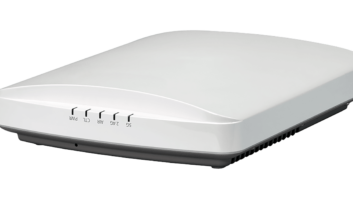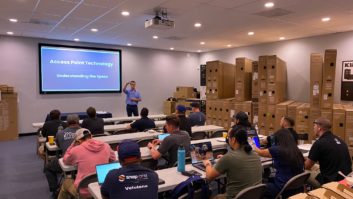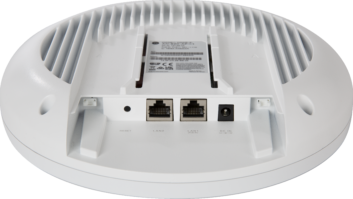by Jeremy J. Glowacki
Many people hear the word “outsourced” and think of Lou Dobbs, India, lost jobs, and a bad NBC sitcom. For custom installation business owners, however, “outsourcing” to third-party technical and business specialists (mostly within the U.S.) has a much less negative connotation as firms attempt to complete more projects with fewer professionals on the payroll.
While the concept of subbing out to install security systems, manage accounting and bookkeeping, or add additional labor for the pre-wire rough-in phase has been common for quite some time, the IT network designer is one of the newer outsource options available to the CEDIA channel.
One of the pioneers in this increasingly essential specialty is Access Networks, in Los Angeles. Since founding the company in 2003, Access Networks CEO Hagai Feiner has been building a team comprised of both IT and CE professionals to deliver networking solutions to the custom integration market nationally. Andy Suk, CTO, joined Access Networks in 2005 and has developed the Access Unity Network and the company’s networking solutions for residential environments. Aaron Gutin, VP of sales, joined the Access Networks team in 2007 to conduct product marketing and development in addition to working closely with dealers to ensure Access meets the ever-increasing demands of the connected home.

Access Networks CEO Hagain Feiner
I recently spoke with Gutin to learn more about Access Networks’ value proposition to the CEDIA channel and how the firm came to serve electronic systems contractors exclusively. According to Gutin, Access Networks’ team boasts more than 20 Cisco and Ruckus Wireless certifications and years of experience, having developed the Access Unity Network, an enterprise-grade, plug-and-play unified home networking solution engineered for the automated home. It is pre-programmed, easy to install, and compatible with all automation systems, AV equipment, and consumer devices, Gutin noted. Every Unity Network includes access to ISP-level remote monitoring and management services. These services provide integrators with a suite of remote diagnostic tools and real-time system analytics, which allow them to avoid costly service calls for common issues such as passphrase adjustments and other value-added services.
“We are integrators just like custom integrators, except what we do is networking specifically and integrate our networking platform—which is comprised of both Cisco Enterprise grade network appliances and Ruckus wireless equipment—into the automated residence,” Gutin explained. “All that means is that the dealer places an order for a package, and it shows up programmed, ready to go for plug-and-play deployment in the field for even their most basic technician to install. It still features all of the complicated configurations that are required to support an automated residence when you have streaming video, streaming audio, automation, gaming, the home office, all that stuff that we all have in our average, every-day home.”
An integrator working with Access Networks will typically receive a package containing the necessary networking appliances. “The integrator gets a relatively customized system for their deployment, but they’re piggybacking on the code that we developed and have been deploying for eight years,” Gutin said. “We’ve deployed our networking platform hundreds and hundreds of times, even though they’re all slightly tweaked for the project, and we’re dealing with Crestron here, Savant there, or Control4 and AMX there.”

Access Networks VP of sales Aaron Gutin
The Wireless Controller product, Gutin explained, unifies all of the wireless antennas within a network and globally manages them. This enables an integrator to change the password in one place and then have it changed everywhere on the network, instead of on one device at a time. The Wireless Controller also manages radio strength adjustments in real time, so the antennas are balanced with one another for even more performance throughout the environment.
According to Gutin, Access Networks has been deploying dual-band “N” antennas since 2006, allowing its networks to broadcast both a 2.4 and 5 GHz network concurrently. “This means that Dad’s old laptop that he gave to his oldest child that has a G radio would log into the 2.4 GHz radio and get G speeds, which is 4 mb per second, and Dad’s new Mac laptop will log in to the 5 GHz radio and get N speeds,” Gutin explained.
Access Networks also offers VLANs as a standard configuration within its network designs. This offers the ability to digitally slice one stack of networking equipment into more than 1,000 different virtual local area networks, each having its own IP scheme. “Typically what we do is separate off the homeowner’s personal devices, computers, NAS drives, and printers into their own VLAN,” Gutin explained. “The entire automation system then gets its own VLAN, and there’s a dedicated guest environment. On large projects there may be a VLAN for CCTV or a services VLAN. We do this so we can divide things up appropriately. The automation company shouldn’t necessarily have direct access to Dad’s home office computer, and it allows us to prioritize traffic by packet type (voice, video, or data, and what VLAN it came from: AV, data, or guest).”
Gutin said that although Access Networks removes the hassle of network design from the hands of the integrator, the onus is still on the ESC to sell the network as an “essential building block” of the house to the homeowner. “You have your concrete foundation and your digital foundation, because it’s not just the automation system that’s going to need the network; it’s their personal computing, their home office, the kids’ gaming and educational tools. It’s a really important infrastructure. And, of course it will increasingly tie into energy management,” Gutin said. “The network, in effect, will be the glue that holds all of those systems together and provides that management solution. We really see it as a profit center for integrators, and they get to sell something that is high-performance.”







